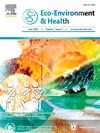小麦籽粒镉积累:积累模型和安全生产的土壤阈值
引用次数: 0
摘要
小麦的高镉积累能力在中国备受关注。确定影响小麦镉积累的关键因素,建立土壤镉阈值预测模型,对小麦安全生产具有重要意义。利用文献资料和田间调查共收集311组土壤-小麦配对数据,土壤和小麦籽粒Cd含量范围分别为0.068 ~ 13.500 mg/kg和0.006 ~ 2.190 mg/kg。相关分析和偏最小二乘路径模型表明,土壤Cd、土壤pH和CEC共同控制着土壤中Cd向小麦的转移。以土壤Cd含量或生物可利用Cd(由CaCl2提取或通过多表面物种形成模型计算)、pH和CEC为输入变量,成功建立多元线性回归模型预测小麦Cd (RMSE = 0.242 ~ 0.327, MAE = 0.188 ~ 0.249)。此外,极端随机树模型(RMSE = 0.221, MAE = 0.165)优于其他七种机器学习算法。根据小麦籽粒Cd允许值,进一步反算出土壤总Cd和生物有效Cd对小麦安全生产的阈值,与现行土壤质量标准相比,保护精度有所提高。研究结果有助于小麦镉积累风险的定量评估,为小麦的安全生产提供有价值的参考。本文章由计算机程序翻译,如有差异,请以英文原文为准。
Cadmium accumulation in wheat grain: Accumulation models and soil thresholds for safe production
The high cadmium (Cd) accumulation ability of wheat has garnered significant attention in China. It is crucial to identify the key factors affecting Cd accumulation in wheat and to develop predictive models to derive the threshold concentration of Cd in soil for safe wheat production. A total of 311 soil–wheat paired datasets were collected from both literature and field surveys in China, in which the ranges of Cd in soil and wheat grain were 0.068–13.500 mg/kg and 0.006–2.190 mg/kg, respectively. Correlation analyses and Partial Least Squares Path Model indicated that soil Cd, soil pH, and CEC together controlled the transfer of Cd from soil to wheat. Multiple linear regression models were successfully established using soil Cd contents or bioavailable Cd (extracted by CaCl2 or calculated using a multi-surface speciation model), pH, and CEC as input variables to predict wheat Cd (RMSE = 0.242–0.327, MAE = 0.188–0.249). Furthermore, the Extreme Random Tree model (RMSE = 0.221, MAE = 0.165) outperformed the other seven machine learning algorithms. The thresholds for both soil total Cd and bioavailable Cd for safe wheat production were further back-calculated according to the permissible value of Cd in wheat grain, which demonstrated enhanced protection accuracy compared to the current soil quality standard. Our findings facilitate a quantitative assessment of Cd accumulation risk in wheat, offering a valuable reference for the safe production of wheat.
求助全文
通过发布文献求助,成功后即可免费获取论文全文。
去求助
来源期刊

Eco-Environment & Health
环境科学与生态学-生态、环境与健康
CiteScore
11.00
自引率
0.00%
发文量
18
审稿时长
22 days
期刊介绍:
Eco-Environment & Health (EEH) is an international and multidisciplinary peer-reviewed journal designed for publications on the frontiers of the ecology, environment and health as well as their related disciplines. EEH focuses on the concept of “One Health” to promote green and sustainable development, dealing with the interactions among ecology, environment and health, and the underlying mechanisms and interventions. Our mission is to be one of the most important flagship journals in the field of environmental health.
Scopes
EEH covers a variety of research areas, including but not limited to ecology and biodiversity conservation, environmental behaviors and bioprocesses of emerging contaminants, human exposure and health effects, and evaluation, management and regulation of environmental risks. The key topics of EEH include:
1) Ecology and Biodiversity Conservation
Biodiversity
Ecological restoration
Ecological safety
Protected area
2) Environmental and Biological Fate of Emerging Contaminants
Environmental behaviors
Environmental processes
Environmental microbiology
3) Human Exposure and Health Effects
Environmental toxicology
Environmental epidemiology
Environmental health risk
Food safety
4) Evaluation, Management and Regulation of Environmental Risks
Chemical safety
Environmental policy
Health policy
Health economics
Environmental remediation
 求助内容:
求助内容: 应助结果提醒方式:
应助结果提醒方式:


